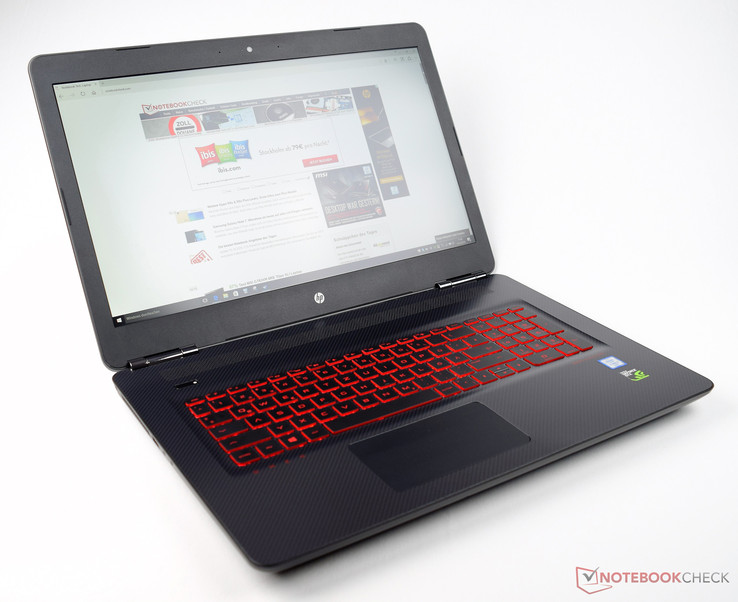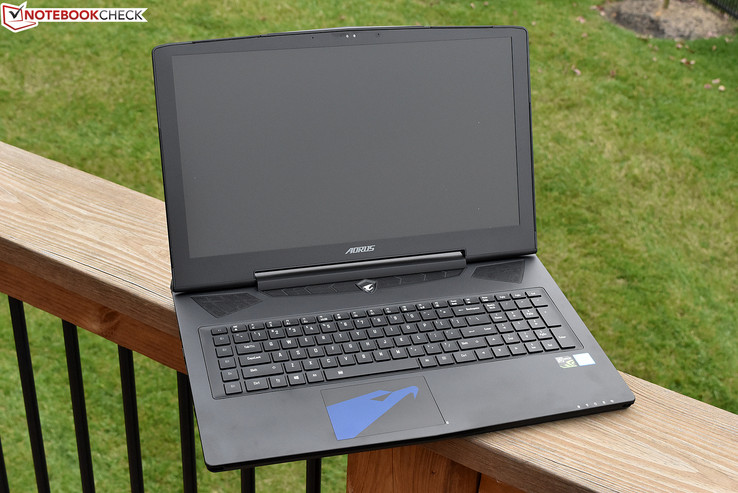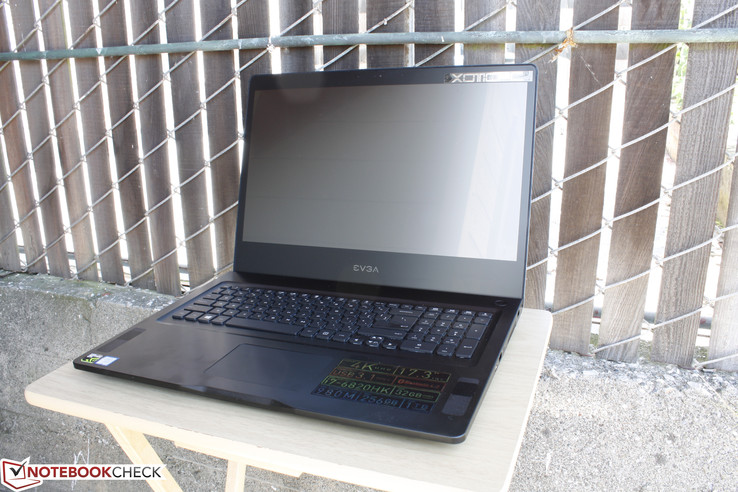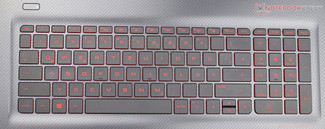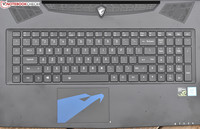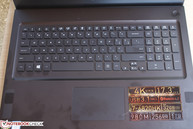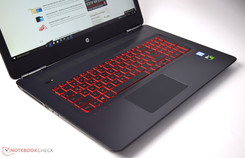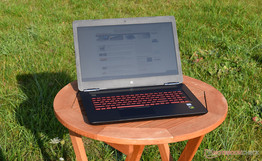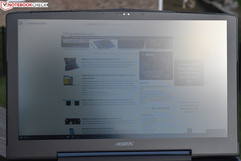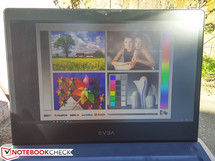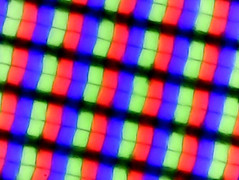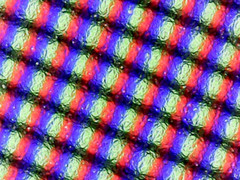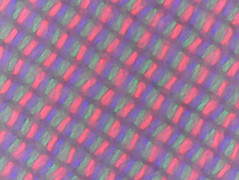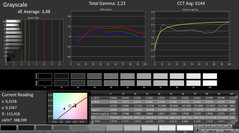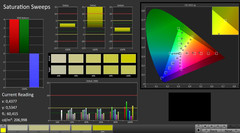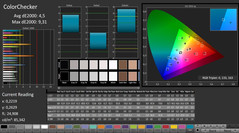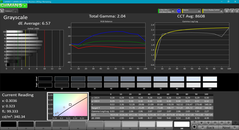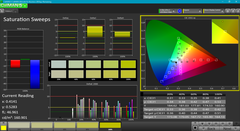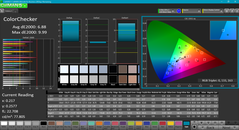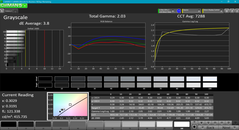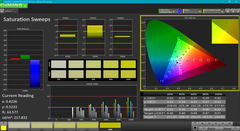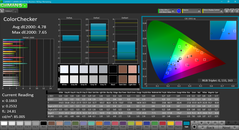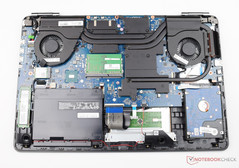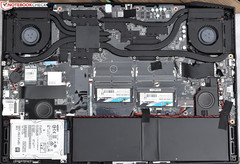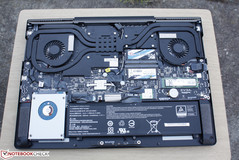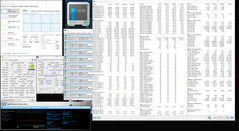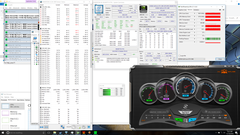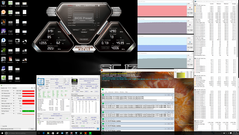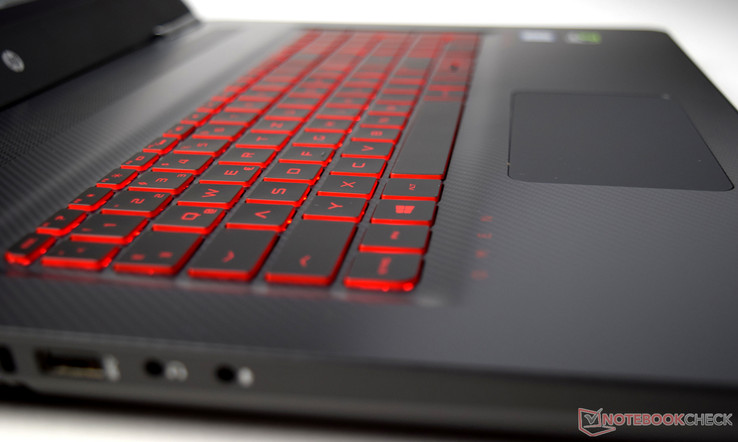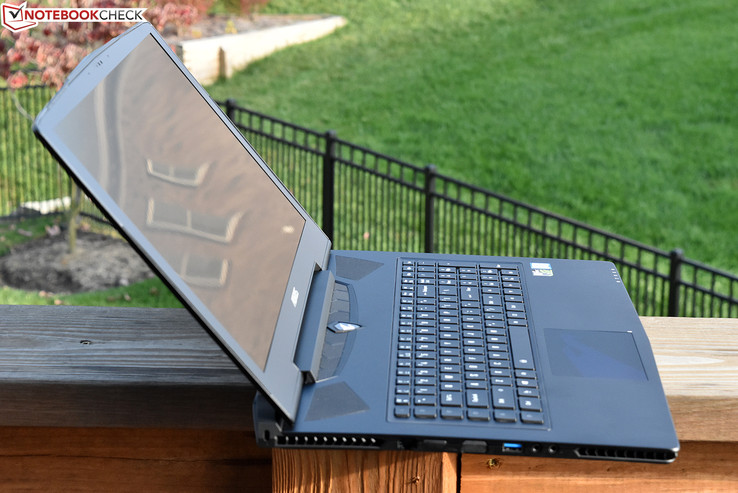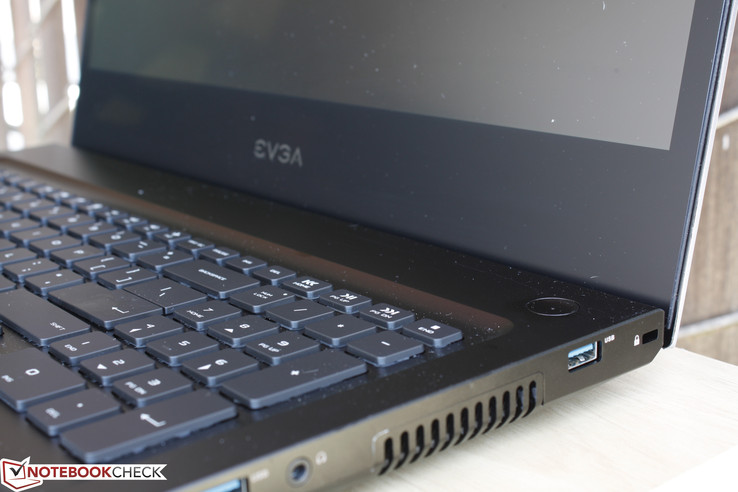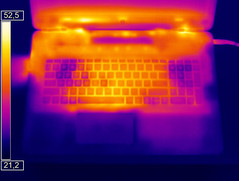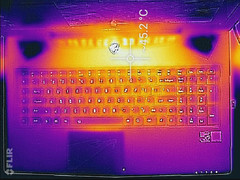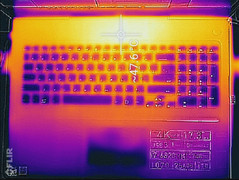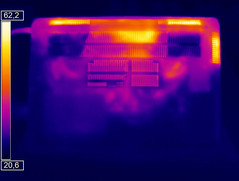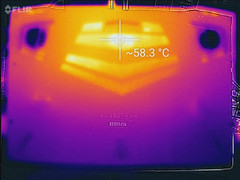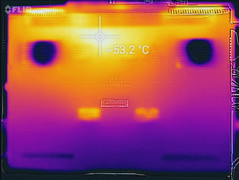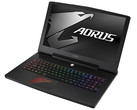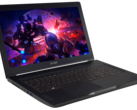Face Off: HP Omen 17 vs. Aorus X7 DT v6 vs. EVGA SC17

Worldwide notebook sales have been on a slump while gaming PCs are predicted to beat the trend for at least the next few years due to the rise of VR. Now that Pascal is widely available, enthusiast-level notebooks are coming in by the truckload from major manufacturers just in time for the Holiday season.
Popular systems with GTX 1070 or GTX 1080 options include the Asus G752/G701, MSI GT73/GT83, and the equivalent Clevo barebones. These notebooks, however, can be as thick as 50 mm, so our comparison today focuses on three thinner alternatives that don't compromise on performance. Instead, they tend to cut corners on secondary aspects including hardware features and noise.
We encourage users to check out our dedicated review pages below for more data and detailed analyses of each of the three models. This comparison is by no means a replacement, but a condensed aid for those on the fence.
Case
Starting with the HP, case quality remains largely unchanged from the original 17-inch Omen. This is unfortunate as the original Omen was based on a budget Pavilion design with plastics and thin bezels. The result is a chassis that creaks in certain areas and a weaker lid susceptible to twists and depressions. In contrast, both the Aorus and EVGA utilize metal for a much more luxurious feel and look compared to the HP. Surfaces are more rigid from top to bottom with the EVGA edging out both in terms of rigidity despite the fact that it is the thinner and smaller notebook. The hinges on each of these notebooks are satisfactory with teetering occurring less frequently on the EVGA.
In terms of weight, both the HP and Aorus are about the same at 3.3 kg each. The EVGA is significantly heavier at over 4 kg, so its superior build comes at a very tangible cost especially for users who intend to carry the notebook between difference locations.
Connectivity
Notable differences in port options can be observed. None of these notebooks support native Thunderbolt 3 and the HP disappointingly includes no USB Type-C port at all. Similarly, the EVGA notebook is overtly missing an integrated SD reader and has only two full-size USB ports despite its size category and price. The Aorus systems feels the most complete in this regard with its dual HDMI 2.0 ports for native 4K60 output, though it is unfortunate that its USB Type-C port is limited to 10 Gbps.
| HP Omen 17 | Aorus X7 DT v6 | EVGA SC17 | |
| USB | 3x USB 3.0 | 3x USB 3.0, 1x USB 3.1 Type-C gen. 1 | 2x USB 3.0, 1x USB 3.1 Type-C gen. 2 |
| Video-out | 1x HDMI 1.4, 1x mDP | 2x HDMI 2.0, 1x mDP | 1x HDMI 1.4, 2x mDP |
| Audio | 3.5 mm Headphone jack, Microphone jack | 3.5 mm Headphone jack, Microphone jack | 3.5 mm combo jack |
| Other | Gigabit RJ-45, SD reader, Kensington Lock | Gigabit RJ-45, SD reader, Kensington Lock | Gigabit RJ-45, 2x Kensington Lock |
| Storage Bays | 1x M.2 2280, 1x 2.5-inch SATA III | 1x M.2 2280, 1x 2.5-inch SATA III | 1x M.2 2280, 1x 2.5-inch SATA III |
Input Devices
The Aorus keyboard is the most attractive of the bunch in terms of features. It offers both individually lit keys and dedicated Macro keys for increased versatility in and out of gaming whereas the HP and EVGA have neither. Furthermore, its full-size Arrow keys should make for easier navigation and fewer mistakes. It's worth noting that the Aorus keyboard can feel slightly tighter due to its additional column of Macro keys and it can be easy to mistake the top left key as the Escape key, so it may take some time for new owners to become accustomed to the layout.
The plain keyboards on the HP and EVGA are not bad either as their keys provide satisfactory feedback and travel when pressed. Beyond this, they offer no significant advantages over the Aorus.
As for the touchpads, the Aorus notebook is ahead once again. At 10.5 x 7 cm, it is noticeably easier to use for multi-touch gestures than on the HP touchpad (12 x 6.5 cm) and its integrated mouse keys are much firmer in feedback than on both the HP and EVGA. While most gamers will likely overlook clickpads when choosing notebooks, there's no denying that they feel like cheap afterthoughts on the costly HP and EVGA.
Display
The matte displays on these 17.3-inch notebooks have a handful of important differences to keep in mind. Aside from their obvious native resolution differences, factors like color coverage and backlight brightness are not the same and, in the case of response times, can directly affect the subjective performance of fast-paced games.
The EVGA display offers the highest native resolution at 4K UHD, the wider color gamut at full sRGB coverage, and the brighter overall screen. This comes at the heavy cost of slow response times that can be a deal breaker to many gamers. In contrast, the QHD Aorus display is almost the exact opposite with its narrower color space, less accurate colors, dimmer display backlight, and lower contrast. In turn, Aorus advertises a 5 ms black-to-white response time and a native 120 Hz refresh rate for a very clean gaming experience with little ghosting.
The FHD HP is the middle-ground of the three systems. Its color space is roughly on par with the Aorus while offering contrast levels and a stronger backlight that are more in line with the EVGA. In turn, the HP lacks the 5 ms/120 Hz display options of the Aorus.
Our HP system exhibits no signs of PWM as opposed to our Aorus and EVGA test units when at low enough brightness level settings.
| HP Omen 17 | Aorus X7 DT v6 | EVGA SC17 | |
| Size | 17.3-inch IPS | 17.3-inch IPS | 17.3-inch IPS |
| Native Resolution | 1920 x 1080 | 2560 x 1440 | 3840 x 2160 |
| Pixel Density | 127 PPI | 170 PPI | 255 PPI |
| Panel ID | LG Philips LGD046E | AU Optronics AUO1096 | Sharp LQ173D1JW31 SHP145E |
| HP Omen 17-w110ng | Aorus X7 DT v6 | EVGA SC17 GTX 1070 | |
|---|---|---|---|
| Display | |||
| Display P3 Coverage (%) | 66.6 | 59.6 | 87.3 |
| sRGB Coverage (%) | 84.1 | 82.8 | 100 |
| AdobeRGB 1998 Coverage (%) | 61.5 | 60.1 | 98.8 |
| Response Times | |||
| Response Time Grey 50% / Grey 80% * (ms) | 37 ? | 21.6 ? | 45.6 ? |
| Response Time Black / White * (ms) | 24 ? | 13.2 ? | 35.2 ? |
| PWM Frequency (Hz) | 59.5 | 1042 ? | |
| Screen | |||
| Brightness middle (cd/m²) | 362 | 339.5 | 399.1 |
| Brightness (cd/m²) | 342 | 309 | 360 |
| Brightness Distribution (%) | 87 | 80 | 81 |
| Black Level * (cd/m²) | 0.31 | 0.45 | 0.4 |
| Contrast (:1) | 1168 | 754 | 998 |
| Colorchecker dE 2000 * | 4.5 | 6.88 | 4.78 |
| Colorchecker dE 2000 max. * | 9.31 | 9.99 | 7.65 |
| Greyscale dE 2000 * | 3.48 | 6.57 | 3.8 |
| Gamma | 2.23 99% | 2.04 108% | 2.03 108% |
| CCT | 6144 106% | 8608 76% | 7288 89% |
| Color Space (Percent of AdobeRGB 1998) (%) | 55 | 54 | 86.9 |
| Color Space (Percent of sRGB) (%) | 84 | 82 | 100 |
| Total Average (Program / Settings) |
* ... smaller is better
Performance
CPU Performance
CineBench benchmarks show the i7-6820HK CPU in our Aorus to be about 20 percent faster than both the i7-6700HQ in the HP and the i7-6820HK in our EVGA. Benchmarks on the Aorus were performed on the notebook's pre-installed overclocking setting compared to our base EVGA system. At stock i7-6820HK clock rates, CPU performance is not significantly greater than the less expensive and more common i7-6700HQ. Thus, unless if users intend on overclocking the CPU, the i7-6700HQ will be more than sufficient for daily tasks and gaming.
See our dedicated CPU pages on the Core i7-6700HQ and i7-6820HK for more benchmarks and comparisons.
| HP Omen 17 | Aorus X7 DT v6 | EVGA SC17 | |
| CPU | 2.6 GHz Core i7-6700HQ | 2.7 GHz Core i7-6820HK | 2.7 GHz Core i7-6820HK |
| TDP | 45 W | 45 W | 45 W |
| RAM | 8 GB DDR4-2400, Dual-Channel, 2x SODIMM | 32 GB DDR4-2400, Dual-Channel, 4x SODIMM | 32 GB DDR4, 1300 MHz, Dual-Channel, 2x SODIMM |
| Cinebench R15 | |
| CPU Single 64Bit (sort by value) | |
| HP Omen 17-w110ng | |
| Aorus X7 DT v6 | |
| EVGA SC17 GTX 1070 | |
| CPU Multi 64Bit (sort by value) | |
| HP Omen 17-w110ng | |
| Aorus X7 DT v6 | |
| EVGA SC17 GTX 1070 | |
| Cinebench R11.5 | |
| CPU Single 64Bit (sort by value) | |
| HP Omen 17-w110ng | |
| Aorus X7 DT v6 | |
| EVGA SC17 GTX 1070 | |
| CPU Multi 64Bit (sort by value) | |
| HP Omen 17-w110ng | |
| Aorus X7 DT v6 | |
| EVGA SC17 GTX 1070 | |
| Cinebench R10 | |
| Rendering Single CPUs 64Bit (sort by value) | |
| HP Omen 17-w110ng | |
| Rendering Multiple CPUs 64Bit (sort by value) | |
| HP Omen 17-w110ng | |
| wPrime 2.10 | |
| 1024m (sort by value) | |
| Aorus X7 DT v6 | |
| EVGA SC17 GTX 1070 | |
| 32m (sort by value) | |
| Aorus X7 DT v6 | |
| EVGA SC17 GTX 1070 | |
| Super Pi Mod 1.5 XS 32M - 32M (sort by value) | |
| Aorus X7 DT v6 | |
| EVGA SC17 GTX 1070 | |
| 3DMark | |
| 1280x720 offscreen Ice Storm Unlimited Physics (sort by value) | |
| HP Omen 17-w110ng | |
| EVGA SC17 GTX 1070 | |
| 1920x1080 Ice Storm Extreme Physics (sort by value) | |
| HP Omen 17-w110ng | |
| Aorus X7 DT v6 | |
| EVGA SC17 GTX 1070 | |
| 1280x720 Cloud Gate Standard Physics (sort by value) | |
| HP Omen 17-w110ng | |
| Aorus X7 DT v6 | |
| EVGA SC17 GTX 1070 | |
| 1920x1080 Fire Strike Physics (sort by value) | |
| HP Omen 17-w110ng | |
| Aorus X7 DT v6 | |
| EVGA SC17 GTX 1070 | |
| Fire Strike Extreme Physics (sort by value) | |
| HP Omen 17-w110ng | |
| Aorus X7 DT v6 | |
| EVGA SC17 GTX 1070 | |
| PCMark 7 | |
| Score (sort by value) | |
| HP Omen 17-w110ng | |
| Lightweight (sort by value) | |
| HP Omen 17-w110ng | |
| Productivity (sort by value) | |
| HP Omen 17-w110ng | |
| Entertainment (sort by value) | |
| HP Omen 17-w110ng | |
| Creativity (sort by value) | |
| HP Omen 17-w110ng | |
| Computation (sort by value) | |
| HP Omen 17-w110ng | |
| System Storage (sort by value) | |
| HP Omen 17-w110ng | |
| PCMark 8 | |
| Work Score Accelerated v2 (sort by value) | |
| HP Omen 17-w110ng | |
| Aorus X7 DT v6 | |
| EVGA SC17 GTX 1070 | |
| Creative Score Accelerated v2 (sort by value) | |
| HP Omen 17-w110ng | |
| Aorus X7 DT v6 | |
| EVGA SC17 GTX 1070 | |
| Home Score Accelerated v2 (sort by value) | |
| HP Omen 17-w110ng | |
| Aorus X7 DT v6 | |
| EVGA SC17 GTX 1070 | |
| X264 HD Benchmark 4.0 | |
| Pass 1 (sort by value) | |
| EVGA SC17 GTX 1070 | |
| Pass 2 (sort by value) | |
| EVGA SC17 GTX 1070 | |
* ... smaller is better
GPU Performance
The GTX 1070 in the HP and EVGA each perform at about the same level as our reference GTX 1070 desktop card. The EVGA system comes out slightly faster than the HP according to 3DMark and even in real-world gaming benchmarks likely due in part to the massive system RAM differences between our two test configurations (8 GB vs. 32 GB of DDR4 RAM). The Aorus, of course, handily outperforms both the HP and EVGA by about 30 to 40 percent in raw graphical power.
See our dedicated GPU pages on the GTX 1070 and GTX 1080 for more benchmarks and comparisons. Our review on the Pascal series will also provide more technical information on the architecture and its new features.
| 3DMark | |
| 1920x1080 Fire Strike Graphics (sort by value) | |
| HP Omen 17-w110ng | |
| Aorus X7 DT v6 | |
| EVGA SC17 GTX 1070 | |
| Fire Strike Extreme Graphics (sort by value) | |
| HP Omen 17-w110ng | |
| Aorus X7 DT v6 | |
| EVGA SC17 GTX 1070 | |
| 3840x2160 Fire Strike Ultra Graphics (sort by value) | |
| HP Omen 17-w110ng | |
| EVGA SC17 GTX 1070 | |
| 3DMark 11 - 1280x720 Performance GPU (sort by value) | |
| HP Omen 17-w110ng | |
| Aorus X7 DT v6 | |
| EVGA SC17 GTX 1070 | |
| Cinebench R15 - OpenGL 64Bit (sort by value) | |
| HP Omen 17-w110ng | |
| Aorus X7 DT v6 | |
| EVGA SC17 GTX 1070 | |
| Rise of the Tomb Raider - 1920x1080 Very High Preset AA:FX AF:16x (sort by value) | |
| HP Omen 17-w110ng | |
| Aorus X7 DT v6 | |
| EVGA SC17 GTX 1070 | |
| BioShock Infinite - 1920x1080 Ultra Preset, DX11 (DDOF) (sort by value) | |
| HP Omen 17-w110ng | |
| Aorus X7 DT v6 | |
| EVGA SC17 GTX 1070 | |
Stress Test
We run both Prime95 and FurMark to simulate maximum stress and to test system stability. These unrealistic conditions do not represent daily workloads and are instead meant to put both the CPU and GPU at 100 percent capacity.
The EVGA system performs the best under extreme loads in terms of maintaining the higher CPU clock rate of 3.2 GHz vs. 2.8 GHz on the HP and 2.6 GHz on the Aorus. This fits in well with the manufacturer's advertisement claims of the SC17 being built for overclockers, so users will generally have more overclocking headroom on the EVGA. The Aorus system is capable of running at speeds of up to 3.8 GHz for all cores only periodically whereas the EVGA can maintain it consistently when its Turbo mode is activated. This does, however, come at the cost of warmer CPU temperatures of well over 90 C on the EVGA when it is stressed to its limits.
Core CPU temperature on the HP is a high 88 C while its GPU runs warmer than the same GPU on the EVGA. It's worth noting that the HP GPU will also throttle just slightly more than on the EVGA and could be partly responsible for the the lower 3DMark scores as shown above.
| HP Omen 17 | Aorus X7 DT v6 | EVGA SC17 | |
| Processor | Core i7-6700HQ | Core i7-6820HK | Core i7-6820HK |
| Rated GPU Core Clock (MHz) | 1442 | 1566 | 1442 |
| Stable GPU Core Clock on FurMark (MHz) | 1114 | 1607 | 1291 |
| Rated CPU Core Clock (GHz) | 2.6 | 2.7 | 2.7 |
| Stable CPU Core Clock on Prime95 (GHz) | 2.8 | 2.6 | 3.2 |
| Average CPU temperature | 88 C | 77 C | 84 C |
| Average GPU temperature | 77 C | 78 C | 73 C |
Emissions & Energy
System Noise & Temperature
Surface temperatures on leaner gaming notebooks such as these tend to be warmer when compared to thicker GT73 or G752 solutions. When compared to each other, however, surface temperatures are not wildly different between them. We were able to record maximum surface temperatures in the mid 50 C range on the bottom surfaces of the three notebooks. As for the front surfaces of the notebooks, our temperature maps below show the relative hot spots on each. The HP, for example, has its warmest area nearest the center of the keyboard whereas the hot spots on the Aorus and EVGA sit directly above the first row of keyboard keys to be farther from the palms and fingers.
Fan noise is loudest on the Aorus in the 51 to 55 dB(A) range when gaming, though not by much over the HP and EVGA. It does, after all, hold the faster and more demanding GPU of the three. The Aorus runs slightly louder when the system is idling as well, so we recommend setting the fan controls to "Quiet" and the Power Profile to "Power Saver" to minimize pulsing of the fans.
| HP Omen 17-w110ng | Aorus X7 DT v6 | EVGA SC17 GTX 1070 | |
|---|---|---|---|
| Noise | |||
| off / environment * (dB) | 30 | 28.6 | 29.2 |
| Idle Minimum * (dB) | 33 | 32.2 | 33.9 |
| Idle Average * (dB) | 34 | 35.2 | 33.9 |
| Idle Maximum * (dB) | 35 | 35.2 | 33.9 |
| Load Average * (dB) | 45 | 51.7 | 43.8 |
| Load Maximum * (dB) | 52 | 55.7 | 53.4 |
* ... smaller is better
Power Consumption
The HP is the most power efficient with the Aorus and EVGA far behind when idling or during low loads. Gaming loads will demand over 200 W and 160 W from the Aorus and EVGA, respectively, which correlates well with the TDP difference between the GTX 1080 (190 W) and GTX 1070 (150 W) GPUs for notebooks. Extreme loads will bring the HP and EVGA on equal footing in terms of power consumption while the generally more efficient HP is at least partially responsible for its longer runtimes as shown in our next section below. It's worth remembering that the HP notebook carries a less demanding FHD screen and a locked i7-6700HQ CPU.
| HP Omen 17-w110ng | Aorus X7 DT v6 | EVGA SC17 GTX 1070 | |
|---|---|---|---|
| Power Consumption | |||
| Idle Minimum * (Watt) | 19 | 31.5 | 27.3 |
| Idle Average * (Watt) | 25 | 33.9 | 34.9 |
| Idle Maximum * (Watt) | 31 | 34.6 | 37.6 |
| Load Average * (Watt) | 90 | 205.6 | 164.4 |
| Load Maximum * (Watt) | 193 | 250.8 | 202.5 |
* ... smaller is better
Battery Life
The HP and Aorus have larger capacity internal batteries than the EVGA by far, though this does not necessarily translate into longer runtimes. The HP can last for four hours compared to just over two hours on the Aorus and EVGA under similar conditions. This is despite the fact that none of the systems have Optimus for improved power savings and so the shorter runtimes can be largely attributed to the overclockable states of the Aorus and EVGA. Aorus systems have a tendency to be less power efficient than competing notebooks of the same size and its runtimes here are shown to be even shorter than on the EVGA.
| HP Omen 17-w110ng 95 Wh | Aorus X7 DT v6 94 Wh | EVGA SC17 GTX 1070 74 Wh | |
|---|---|---|---|
| Battery runtime | |||
| Reader / Idle (h) | 7.2 | 3 | 4 |
| WiFi v1.3 (h) | 4.1 | 2.4 | 2.7 |
| Load (h) | 1.9 | 1.6 | 0.9 |
Verdict
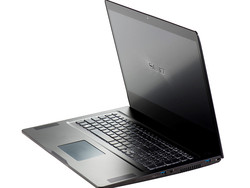
The Omen 17 retails for hundreds less than both the Aorus X7 DT and EVGA SC17 and this shows in its less-than-impressive chassis. It does, however, carry redeeming qualities including its brighter and more color accurate display panel than on the Aorus with faster response times than on the EVGA. Battery life is noticeably longer as well since the notebook does not emphasize CPU overclocking and uses a less demanding FHD screen.
The SC17 excels in both construction quality and overclocking that are made more impressive considering the size of the unit. Unfortunately, it gives up a lot of connectivity features and could have benefited from more display options.
The latest Aorus system feels more like a "complete" gaming notebook in comparison even if it means sacrificing some overclocking potential and case rigidity along the way. Display colors and contrast take a hit in order to have 5 ms response times and 120 Hz refresh rates. Nonetheless, this arguably caters better to gaming enthusiasts over the wider color gamut and increased ghosting from the 4K UHD panel on the EVGA.
| HP Omen 17 | Aorus X7 DT v6 | EVGA SC17 |
|---|---|---|
+ More power efficient; Longer battery life + Less expensive | + Metal surfaces + HDMI 2.0 + Dedicated Macro keys and RGB backlight + easier-to-use trackpad + 5 ms/120 Hz QHD display options | + Thinner and stronger chassis; Metal surfaces + USB Type-C Gen. 2 port + Native 4K UHD display + Brighter display backlight and wider color gamut |
- Weaker plastic design - No USB Type-C - Warmer CPU operating temperatures | - Dimmer display; Narrower color gamut - Poorer display contrast - Louder fans under load | - Significantly heavier - Fewer connectivity options;Only 2x USB 3.0 ports and no SD reader - Poorer trackpad mouse keys - Longer display response times; More ghosting |
HP Omen 17
Price comparison
Aorus X7 DT v6
Price comparison
EVGA SC17
Price comparison
See more quick comparisons in our Face Off series:
- Dell XPS 15 vs. Apple MacBook Pro 15 vs. Asus ZenBook Pro UX501
- Aorus X3 Plus vs. Gigabyte P34W vs. Razer Blade 14
- Dell XPS 13 vs. Apple MacBook Pro 13 vs. Asus ZenBook UX305
- HP EliteBook 820 G2 vs. Lenovo ThinkPad X250 vs. Dell Latitude 12 E7250
- Asus ROG G751 vs. Dell Alienware 17 vs. MSI GT72 Dominator
- Lenovo ThinkPad T450 vs. Acer TravelMate P645 vs. Dell Latitude 14 E5450
- Dell Alienware 15 vs. Clevo P751ZM vs. MSI GE62
- Acer Aspire V17 Nitro vs. Asus N751 vs. HP Envy 17
- Samsung Galaxy Tab S 8.4 vs. Sony Xperia Z3 Compact vs. Dell Venue 8 7000
- Asus EeeBook X205TA vs. Lenovo S20 vs. Acer Aspire ES1
- Microsoft Surface Pro 3 vs. Asus Transformer Book T300 Chi vs. Toshiba Portege Z20t
- Lenovo ThinkPad Edge E550 vs. Acer Aspire E5 vs. HP ProBook 450 G2
- HP Pavilion 15 vs. Lenovo IdeaPad Z50 vs. Toshiba Satellite S50
- Apple MacBook Air 13 2015 vs. Samsung ATIV Book 9 900X3G vs. Asus ZenBook UX303
- Asus ROG G501 vs. Lenovo Y50 vs. Acer Aspire V15 Nitro
- OnePlus 2 vs. Honor 6 Plus vs. Motorola Moto X Play
- Lenovo Yoga 500 vs. Dell Inspiron 15 7000 vs. Toshiba Satellite Radius 15
- Apple iPhone 6S Plus vs. Huawei Mate S vs. LG G4
- Dell Inspiron 15 5558 vs. Lenovo Z51 vs. Acer Aspire V3 574G
- MSI GT72S vs. Asus G752 vs. Clevo P870DM
- Microsoft Surface Book vs. Dell XPS 13 InfinityEdge vs. Apple MacBook Pro Retina 13
- Microsoft Surface Pro 4 Core i7 vs. Surface Pro 4 Core i5 vs. Surface Pro 4 Core m3
- Lenovo Yoga 900 vs. HP Spectre x360 13 vs. Dell Inspiron 13 7348
- Lenovo ThinkPad T450s vs. HP EliteBook Folio 1040 G2 vs. Dell Latitude 14 E7450
- Asus GL552JX vs. Acer Aspire V15 Nitro VN7 vs. MSI GP62 2QE
- MSI WT72 vs. Lenovo ThinkPad P70 vs. HP ZBook 17 G2
- Microsoft Surface Pro 4 vs. HP Spectre x2 12 vs. Fujitsu Stylistic Q665
- Dell XPS 13 9350 vs. XPS 13 9343 vs. XPS 13 9333
- Lenovo Ideapad Y700 15ISK vs. Gigabyte P55W v5 vs. Dell XPS 15 9550
- Lenovo ThinkPad X260 vs. Dell XPS 12 9250 vs. Razer Blade Stealth
- Lenovo ThinkPad X1 Carbon vs. HP EliteBook Folio 1040 G3 vs. Dell Latitude 14 E7470
- Aorus X5S v5 vs. MSI GS60 6QE vs. Acer Predator 15
- Lenovo ThinkPad 13 vs. Acer Aspire S 13 vs. HP Spectre 13
- Toshiba Tecra Z40 vs. Acer TravelMate P648 vs. HP EliteBook 840 G3
- Apple MacBook 12 Core m3, Core m5, and Core m7
- Lenovo Yoga 3 Pro 13 vs. Asus Zenbook UX360CA vs. Dell Inspiron 13
- MSI GT73VR vs. Asus G752VS vs. Alienware 17 R3
- Microsoft Surface Pro 4 vs. Acer Aspire Switch Alpha 12 vs. HP Elite x2 1012 G1 vs. HP Spectre x2 12 vs. Huawei MateBook
- Lenovo ThinkPad T460s vs. ThinkPad X1 Yoga vs. ThinkPad Yoga 460
- Asus X302UV vs. HP Envy 13 vs. Lenovo IdeaPad 710S
- Toshiba Portege Z30 vs. Dell Latitude 13 7370 vs. HP EliteBook 1030 G1


